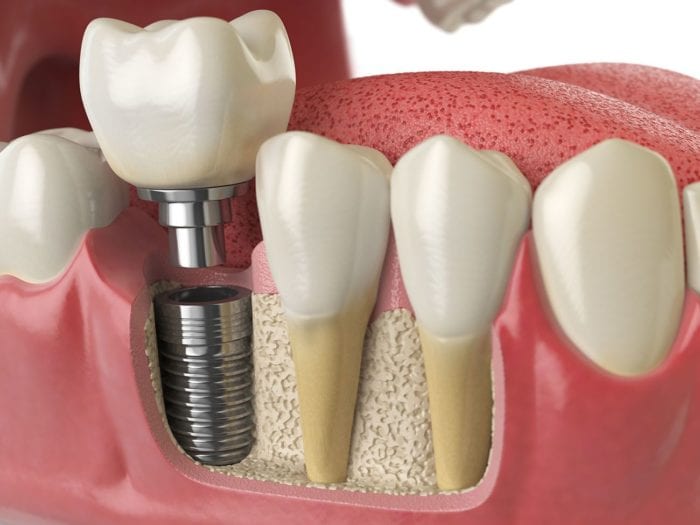Dental Sense Fundamentals Explained
Dental Sense Fundamentals Explained
Blog Article
Getting My Dental Sense To Work
Table of ContentsThe smart Trick of Dental Sense That Nobody is DiscussingUnknown Facts About Dental SenseThe Best Strategy To Use For Dental SenseOur Dental Sense Ideas
are medical devices surgically implanted into the jaw to bring back a person's ability to chew or their look. They supply support for man-made (phony) teeth, such as crowns, bridges, or dentures. When a tooth is shed due to injury or illness, an individual can experience issues such as quick bone loss, malfunctioning speech, or changes to eating patterns that lead to discomfort.Oral dental implant systems are composed of an oral implant body and oral implant abutment and may also include an abutment addiction screw. Front tooth filling. The dental implant body is operatively put in the jawbone instead of the tooth's origin. The dental implant joint is usually connected to the dental implant body by the abutment fixation screw and extends with periodontals right into the mouth to sustain the affixed fabricated teeth
(https://businesslistingplus.com/profile/dentalsense1/)Structure of The Oral Implant System choosing dental implants, talk to your dental company about the prospective benefits and dangers, and whether you are a candidate for the procedure. Points to think about: Your total health is a vital aspect in establishing whether you are an excellent candidate for dental implants, just how long it will certainly take to heal, and how much time the dental implant may remain in place.
Smoking cigarettes might impact the healing process and decrease the long-lasting success of the implant. The recovery process for the implant body may take a number of months or longer, during which time you commonly have a short-lived abutment in area of the tooth. the dental implant treatment: Meticulously follow the oral health instructions provided to you by your dental copyright.
Dental Sense for Dummies
Implant failing can result in the need for one more surgery to fix or replace the dental implant system. Recovers the ability to chew Restores aesthetic appearance Assists maintain the jawbone from shrinking due to bone loss Preserves the health of the surrounding bone and periodontals Helps maintain nearby (neighboring) teeth secure Enhances quality of life Damages to surrounding all-natural teeth during dental implant placement Injury to the surrounding tissues throughout surgery, such as sinus perforation Injury throughout surgical treatment (for example, crack of bordering jawbone) Poor function, such as seeming like the teeth do not bite together typically A feeling that the tooth is loose or turning in area resulting from an abutment screw loosening Implant body failure (looseness of the implant body) because of systemic infection, which may be much more likely in individuals with uncontrolled diabetes mellitus due to local infection in bone and periodontals sustaining the dental implant body due to delayed healing, which might be extra most likely in individuals that smoke Trouble cleaning the gums around the dental implant, leading to inadequate oral health Without treatment periodontal disease Post-surgical feeling numb because of nerve impingement or damage Constantly notify healthcare suppliers and imaging technicians that you have dental implants before any magnetic vibration imaging (MRI) or x-ray procedures.
FDA is not aware of any kind of adverse events reported for MRI or x-ray treatments with oral implants. Oral implants systems are typically made of materials that adhere to global agreement requirements of the International Organization for Standardization (ISO) or ASTM International. These standards have details of what makes a secure product.

A dental implant is a structure that replaces a missing out on tooth. With screw-like devices, the specialist inserts a dental implant right into the jawbone, and it acts as an anchor for a synthetic tooth, called a crown.
Dental Sense Fundamentals Explained
Some individuals are not qualified for oral implant surgical procedure. It is for dental cosmetic surgeons to operate on people with: intense illnessuncontrollable metabolic diseasebone or soft cells disease or infectionIf these concerns are resolved, a person can have the surgery. In, oral specialists avoid operating people with: If individuals with any of the above undergo dental implant surgery, there is a higher threat of the implant failing.

Dental dental implant surgical procedure is a tailored procedure. It's not the same for everyone. But the following offers a basic summary of what you can anticipate your dental professional, dental surgeon, periodontist or prosthodontist to do: Put the dental implant operatively. Offer you time to recover. Affix the article and last crown, bridge or denture.
Next off, your specialist will carefully put the oral implant into your jaw. Lastly, your specialist will reposition your periodontals and close the cut with stitches. If your implant is near the front of your mouth, your dentist will make a short-lived tooth for you to put on till you recover. In this way, you will not have a gap in your smile while you recover.
Fascination About Dental Sense
During the recovery phase, your jawbone must fuse to the dental implant. This procedure can take anywhere from 3 to 9 months.
Once your dental implant heals, your dental professional can attach the joint (small port post) and your last remediation (crown, bridge or denture). This generally takes about one hour to complete and might require a 2nd minor surgical treatment. You shouldn't feel any type of pain throughout your dental implant treatment because your service provider will use medication to Source numb your periodontals.
Report this page